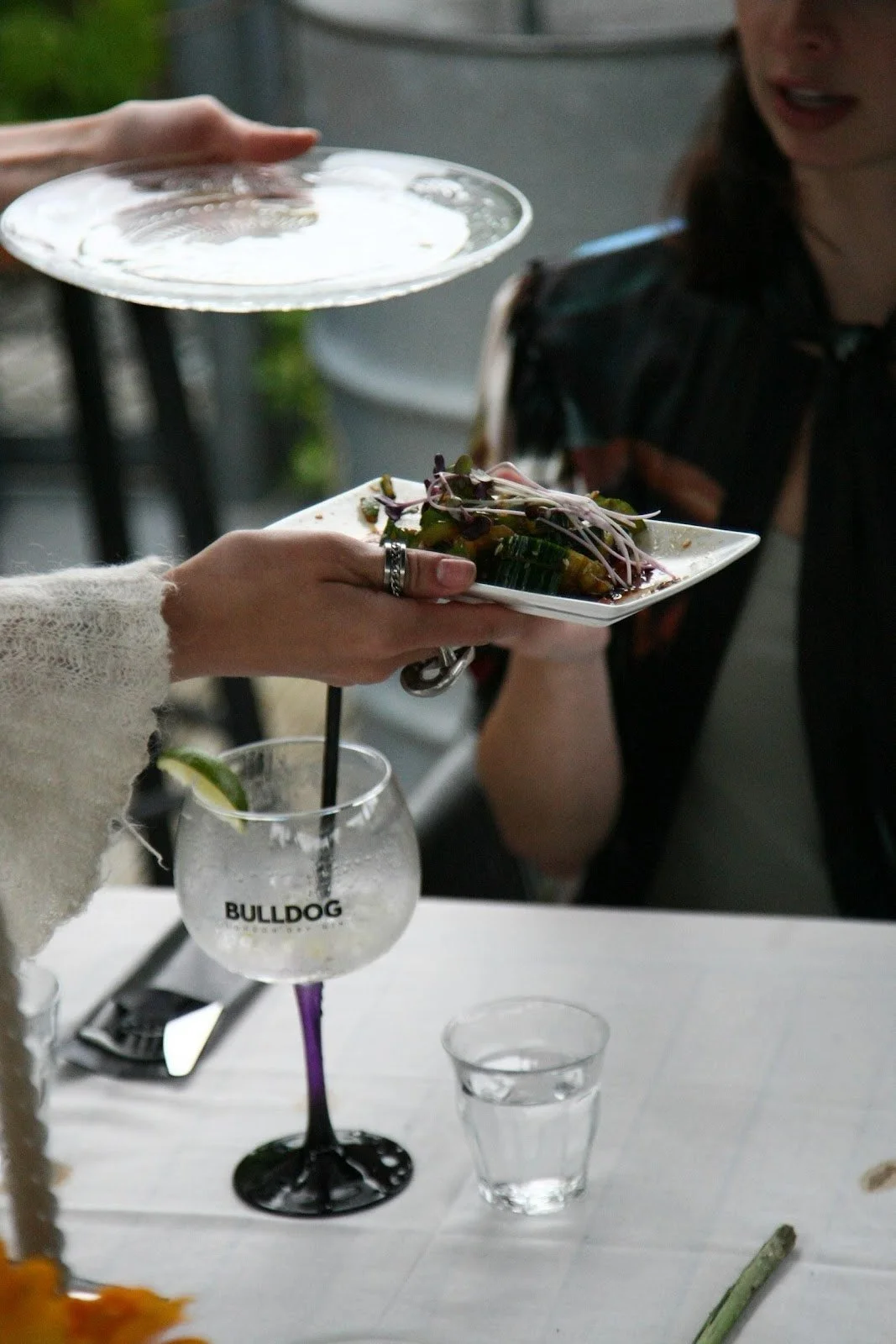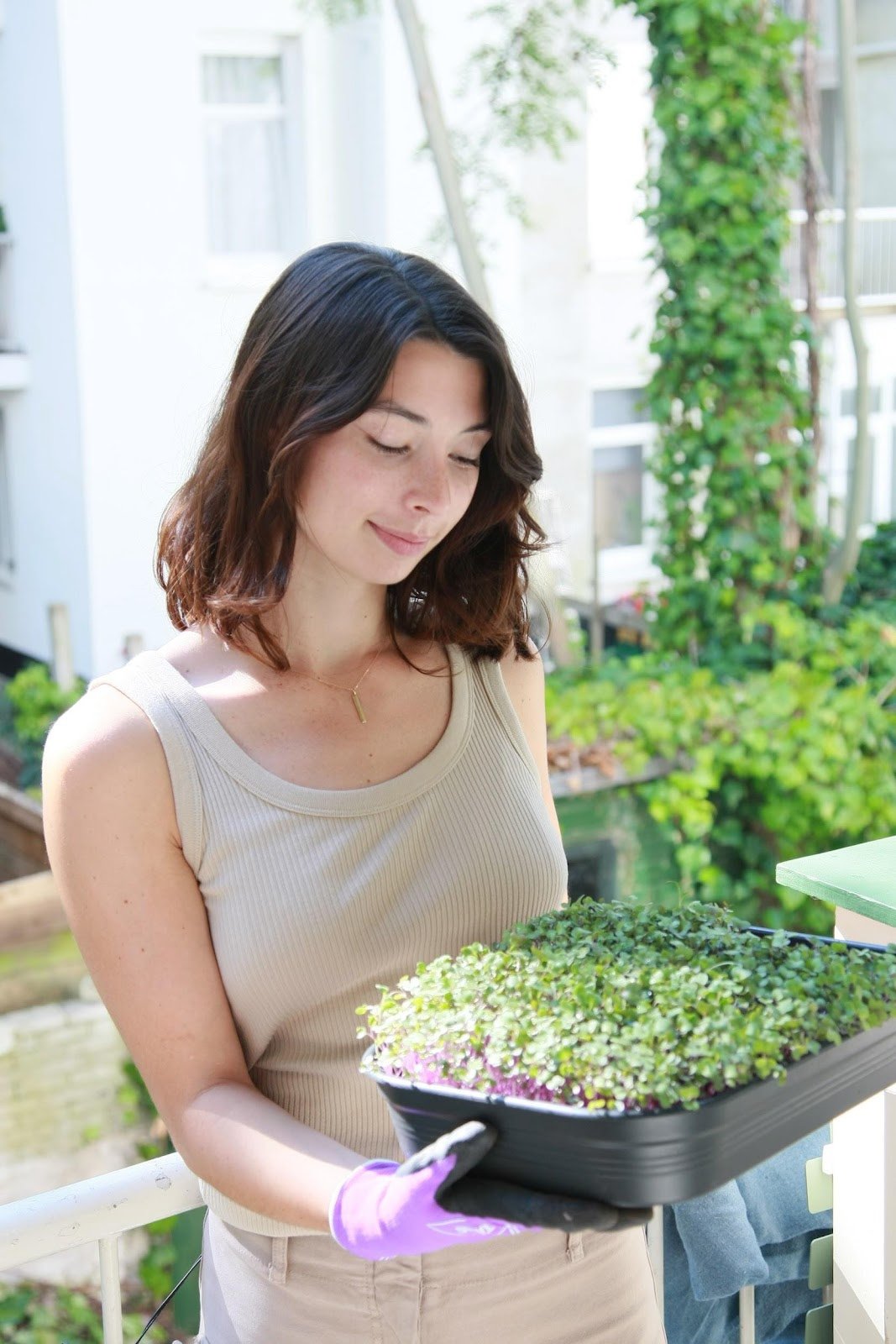The Billion-Euro Mini Vegetable?
Why Microgreens Haven’t (Yet) Taken Root in the Netherlands
Written by Franciszek Maurer
Microgreens are young edible seedlings famed for being nutrient-rich, easy to grow, and very Instagrammable. But as new data shows the industry has reached a staggering $1.7 billion global valuation, many are left asking questions: What are they, who’s producing them, and is this just a Gen Z Tik Tok trend or perhaps something more?
To understand this growing industry (pun-intended), it is important to first introduce the plants themselves. Microgreens are varieties of common vegetables such as broccoli, radish, or peas harvested 7-21 days after germination. While the exact date of harvesting will differ based on the specific plant, microgreens are almost always harvested in the cotyledon stage; when the first leaves emerge from the seed. For the plants, these cotyledons are crucial as they are the initial food source of the seed while it is buried in soil and cannot yet photosynthesise. For us the consumers, the cotyledons are important because they are rich in nutrients. In fact, these tiny leaves are so dense in vitamins and key minerals some studies find microgreens to be 30-40 times more nutrient dense than their fully grown counterparts.
It is important to recognize, however, high nutrient density does not translate to being able to full-fill your dietary requirements with microgreens. A common criticism of the industry is that the high price of microgreens, at an average retail price of €4.70/100g in 2024 which can be as much as €15/100g depending on variety, implies that consuming significant quantities of microgreens is unrealistic for most consumers. But, that is not necessarily the purpose of microgreens.
Since their inception microgreens have thrived in high-end restaurants, vegan diets, and wellness routines not just because they are nutritious, but because they are full of flavour, have beautiful appearance, and are adaptable to many dishes and cuisines It is this combination of attributes that has spurred the demand for microgreens around the world.
The early days
Although Microgreens might look like a Gen Z wellness trend, they trace their roots to 1980s California, where chefs started using them to elevate the color and texture of high-end dishes. Long after their culinary debut, microgreens eventually entered grocery retail in the 2010s. However, the huge spike in their popularity leading to 10-15% year-on-year growth was sparked by the internet. Through Youtube DIY channels, Reddit, health blogs, and other online communities, microgreens became a sort of do-it-yourself movement as people realized the ease of growing microgreens. This virality grew parallel to the health conscious consumer as people, particularly in the United States, began to shift towards healthier diets.
Since its explosion in North America, the global microgreen industry has flourished around the world, expecting to reach $3.4 billion by 2030 at approximately CAGR 10% (that’s corporate speak for compound annual growth rate). But while the North American market matures and the Asian grows at a whopping 14.1% annually, Europe lags behind. In 2022, the European continent microgreens industry was valued at $542 million, much less than its American counterpart, with growth annualized projections of 10.6%, less than the young Asian market. Although the lag is not significant a closer look may help to reveal some regional inconsistencies with the Netherlands playing a key role.
Dutch Microgreens in Context
At a glance the Netherlands seems particularly attuned to microgreens with its high urban density, environmental awareness, and relatively high incomes. But market research paints a completely different picture, or to be precise doesn’t paint one at all. Despite numerous studies on the European microgreens market, where Germany and Spain seem to dominate, data on the Netherlands seems nonexistent. Even more interestingly, the country is home to key industry leaders such as Koppert Cress; a global microgreens player operating large local and international production centers that output approximately 70 varieties of microgreens and serve as many as 80,000 restaurants per week. Other major companies such as Growy also operate out of the Netherlands, yet the local market demand seems to be relatively stale.
Dutch Consumer Demographics & Preferences
To uncover the market dynamics that steer the Dutch market, I interviewed Alix Briere of Lovingreens, an Amsterdam-based microgreens producer selling at local markets and online. Her experience reveals some patterns that shine a light on the Dutch perspective.
As a small-scale producer she has spent countless days at weekend markets chatting to her customers. With almost two years of experience in Amsterdam she identifies three main market segments. Firstly, are the older, and frankly wealthier, Amsterdammers. Alix classifies this group as health and community oriented making home grown microgreens particularly appealing to them. Secondly, are small and aesthetic restaurants. From experience, Alix notes she struggles working with large chains, which expect huge volume. Boutique restaurants, on the other hand, require a more manageable supply of microgreens, while leading to more personal business relationships that are mutually beneficial for both partners. Finally, and perhaps most surprisingly, a significant chunk of orders for microgreens comes from (American) tourists. These are younger people, who are used to eating microgreens back home, where their market and accessibility is much more widespread.
This set of consumer demographics tells an interesting story. It seems that the Netherlands, just like the rest of the world, struggles to overcome the high price of microgreens. Only wealthier consumers or businesses with bigger budgets are willing to pay the heftier price. In fact, Alix recalls Dutch people coming up to her stand keen to try the microgreens, but say they cannot justify the price. More importantly, the case of American tourists reveals a tendency for repeat purchases. In other words, getting people through the door to buy their first batch of microgreens can be tough, but once you do, the customers tend to become regulars.
And Alix, is no stranger to loyal regulars, some customers come back week after week, some even have open tabs. Their consistency helps Lovingreens financially while also allowing Alix to form connections with her consumers who give feedback and help improve the product.
Market Constraints
While Lovingreens has a clear set of target demographics, microgreens producers face several key limitations in the Dutch market on top of price sensitivity. When asked about the challenges Lovingreens faces Alix did not have to think long, she said.
“Space, lack of space…”
Alix Briere founder of Lovingreens
Despite microgreens being grown on vertically stacked racks, and well being micro, space has been a huge constraint on her ability to scale. Only until May of 2025, Alix like many other small urban farmers, grew all of her produce in her small studio apartment in Amsterdam West. With about a third of that studio being taken up by racks and growing equipment, scaling production was challenging, but finding growing space in Amsterdam was not feasible.
Alix recalls trying extensively, but viable growing locations equipped with electricity and running water were either far too expensive, or too far away from the city, defeating the whole “urban grown” concept.
And that’s not all. While selling at the weekend market Alix has noticed varying perspectives on microgreens. Young city dwellers generally adore the concept, praising microgreen ingenuity and techy-ness. On the other hand, people involved in traditional farming associate urban grown produce with the use of artificial fertilizers and poor nutrient quality. Such negative connotation stems from the rise of hydroponics which are dependent on the use of fertilizers to reach nutrient saturation.
Between limited space, price-sensitive customers, and wavering trust, it’s clear that Dutch microgreens producers are being squeezed from both the demand and supply side.
Opportunity for Growth
Despite the economic hurdles, there’s still plenty of green ahead. Dutch firms like Koppert have shown to be capable of scaling production, Alix herself states that if needed she has the capacity to grow more, the demand is just not quite there.
Many producers are experimenting with ways to get the consumer “through the door”. A slurry of ingenious microgreens derived products have arisen from pestos, smoothies, spice mixes and many others. In addition, local producers are continuously fighting to grow their distribution channels, making countless cold calls to restaurants and marketing themselves at weekend markets.
But looking back at the history of microgreens in the US, the stories of early Koppert Cress, as well as current experiences of Lovingreens point to another, more fundamental approach: building community. In particular, Koppert CEO Stijn Baan emphasizes that community was key to microgreens’ success in the U.S. When talking about small scale producers in an interview with Microgreens consulting Baan recommends:
“[...] make sure you keep that connection with the end user because they will give you feedback that’s far more relevant…”
Stijn Baan CEO of Koppert Cress via Microgreens Consulting
Akin to the experience of Alix who immensely benefits from the relationships she has with her customers, Baan encourages all small scale producers to lean into the community aspect of growing microgreens.
Afterall, the early days boom of microgreens in North America was spurred by the rise of online DIY microgreens communities. So perhaps producers in the Netherlands need to not only innovate, but also embrace their communities. Through building relationships with customers, and maybe even showing them how to grow their own microgreens, the industry can grow into something more than a passing Gen Z Tik Tok trend; perhaps the industry can become a way for people to connect.
Final thoughts
The Dutch microgreens market is stuck between unrealized potential and staggering demand, but the path forward is becoming clearer. The Netherlands is a global producer domestically tackled with price sensitivity, consumer skepticism, and spatial constraints that hold back small and large scale farms alike. Yet with the right strategy, especially one focused on the social aspect of growing microgreens, the tiny plants could become a regular feature in Dutch life.
Microgreens may be tiny, but their impact on sustainable urban food systems, and consumer health, could be huge. The question is whether the Dutch market is ready to embrace the greens.




